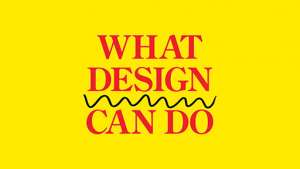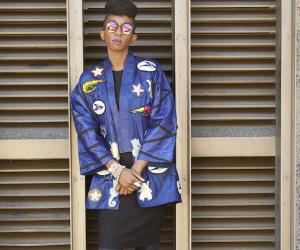From the Series
Local and international guests flocked to the Muziekgebouw Aan ’t Ij on 30 June and 1 July to experience the annual What Design Can Do conference. The concert hall on Amsterdam’s IJ waterfront hosted a number of musical acts and around 20 speakers who all tackled the way global issues could be addressed with innovative forms of design. Water, the refugee crisis, housing and social design were all part of this year’s programme. In a new twist, a segment of some of Africa’s premier creative leaders, curated by Design Indaba founder Ravi Naidoo, stole the show on the second day, proving that global solutions can be found in the developing continent.
DAY ONE
Opening the conference, Netherlands-based journalist Tracy Metz took on the topic of climate change by saying that it cannot be “fixed” with design. Instead, the 25-year media veteran argued that we should make our cities amphibious. Through sustainable, urban models of floating cities, Metz believes we can adapt to our changing world in order to survive, becoming as fluid as the water we build on.
The next speaker, Michael Uwemedimo took a more concentrated approach to designing for social change. Through his company CMAP, which stands for Collaborative Media Advocacy Platform, Uwemedimo and his partners create new opportunities for the people of Port Harcourt, Nigeria. Living with the ever-present threat of eviction, the residents of Port Harcourt have found a voice through initiatives like the Human City Project and a media campaign called People Live Here.
In his talk, Uwemedimo emphasised the importance of working alongside the individuals who are most affected by the initiatives set into motion. He drew attention to the wealth of expertise on the ground, calling on initiatives to foster a collaborative approach to design.
Nigerian-born architect, designer and "urbanist" Kunlé Adeyemi took to the stage for the third round of talks. Working closely with Uwemedimo on community-based projects like the Chicoco Radio Media Center; the amphibious building in Port Harcourt, Adeyemi also stressed the importance of fostering a space in which the community is given the tools with which to adapt and thrive. His Amsterdam-based agency NLÉ is currently developing a number of urban, research and architectural projects in Africa, one of which is the iconic Makoko Floating School. Although the school was recently destroyed in a series of floods, Adeyemi is confident that its next iteration will be even better equipped for its purpose.
Dutch Arabist and author Petra Stienen opened the dialogue around the refugee crisis in her talk. Using her extensive knowledge of Arab politics, Stienen also functioned as a jury member for the WDCD Refugee Challenge, a competition that called for solutions to the problems faced by refugees and their host communities.
The next three speakers addressed the importance of storytelling in the new age. Journalist Eefje Blankevoort is best known for Prospektor, a journalism production company driven by the need for independence. While Christopher Balaresque, Marketing Director of Arjowiggins Creative Papers, is known for creating the Paper Book, an enormous sample book containing the complete collection of Arjowiggins‘ creative papers. Musical storytelling was the focus of Machine, a Dutch graphic design collective. Known as Dj Mark “The Machine”, Mark Klaverstijn is a regular feature at WDCD.
The session was capped by a musical performance from musician, DJ and multimedia artist Hatim Belyamani aka officerfishdumplings, who started the project REMIX ←→ CULTURE in 2012.
The afternoon session of day one kicked off with an insert that was a little on the weird and wonderful side. Visual artist Floris Kaayk taps into fiction to explore the possibilities of modern technology. Looking at the way biotechnology has evolved, Kaayk created OSCAR, a series of interconnected videos that tells the sci-fi story of a modular life form.
He also designed the eerie visuals for the award-winning music video “Witch Doctor” alongside Studio Smack and De Staat foreman Torre Florim. The video is a visualisation of a demagogue’s power and has been viewed over 10 million times.
Going from weird to witty, founder and art director of the independent UK label Factory Records Peter Saville took to the stage alongside renowned journalist Rick Poyner as the subject of a mock interview. The banter-filled exchanged picked apart the innovative ways Saville revolutionised the album cover by omitting information about artists or titles and fundamentally questioning modes of consumption and communication.
Mapping the journey in his own career, South African satirist Jonathan Shapiro took to the stage next. His talk took the audience on a comedic journey of South Africa’s segregated past. He also highlighted the ways in which artists can speak truth through their work despite the threat of persecution.
Ending the first day of talks, Amsterdam-based creative duo Lernert Engelberts and Sander Plug, aka Lernert & Sander, brought a medium to the stage in the hopes that she would be able to predict their creative futures. Known for moving effortlessly between conceptual art and commercial advertising, the abstract artists were unsurprisingly told that they had innovative projects in the futures.
DAY TWO
Poyner opened the second day of the conference by addressing what design can do for music. His talk centred on the integral relationship between image and music, proving that the album cover has not died despite the digital age.
Moving into the field of social design, Nynke Tromp called for social design to be regarded as a discipline. She stressed the importance of measuring the impact of social initiatives.
Working as an assistant professor Social Design & Behaviour Change at the department of Industrial Design, Delft University of Technology, Tromp questioned the effect designing for convenience has had on the modern world.
Integral to changing the way we design is the practice of design research, says Geke van Dijk who founded STBY together with Bas Raijmakers. Based in London and Amsterdam STBY specialises in creative research for service design and innovation. As a partner of the Refugee Challenge, the duo stressed the importance of addressing a challenge using multiple angles, workshops, and consultation of those affected.
The next one and a half hour segment was curated by Ravi Naidoo. In his 15 minute interlude, the founder of Interactive Africa and the Design Indaba conference highlighted the importance of using Africa as a catalyst for great design. Following his steam, technologist Juliana Rotich addressed low-tech solutions to education setbacks in rural Africa and Rwandan architect Christian Benimana highlighted his plan to train a generation of human-centred African designers. One such designer, fashion icon Selly Raby Kane highlighted her own work in fashion, detailing the continent’s need to tell its own stories. Ending off the segment, multidisciplinary artist Stephen Bassene, also known as IBAAKU gave the audience an electric taste of Senegal’s avant-garde music scene.
On a slightly softer note, Joep Beving delivered an experience-design-centred piano piece accompanied by bespoke visuals. Opening the afternoon session, Beving’s piece set the stage for Marcus Lyall, a UK-based designer and director who uses sound, light and imagery to create installations for brands around the world. He recently exhibited an installation in which light and sound react to the thoughts of the user.
Ending off on the importance of imagery in design, Brazilian advertising guru Marcello Serpa told the audience that a good design has to be both simple and unpredictable. Serpa is Brazil’s most honoured art director, with 149 Cannes Festival Lions in his trophy cabinet, including Latin America’s first Grand Prix.


















